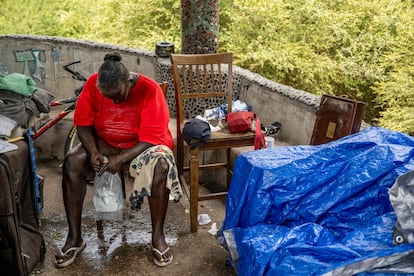Extreme heat scorches one in three Americans
High temperatures have triggered alerts in dozens of cities in a 2,000-mile swath of land stretching from the Midwest to the West. Phoenix is close to breaking a record for most consecutive days above 104° F


Extreme heat is beating down on the Western United States, home to just over a third of the nation’s population. The region’s 113 million people are under high temperature warnings. For weeks now, a heatwave has punished dozens of towns in Texas, New Mexico, Arizona and California. The heat has broken two global records this year, and from Oregon to Louisiana — a 2,000-mile (3,200-kilometer) stretch of land — it has not let up.
In Phoenix, temperatures have reached or exceeded 98.6 degrees Fahrenheit (37 degrees Celsius) since June 13. It’s a hot streak. The situation is getting worse, as the Weather Service has extended forecasts of extreme heat. Meteorologists have warned that highs of 116.6º F (47º C) will be recorded in Phoenix this Saturday and Sunday. All signs indicate that, on Monday, the summer of 2023 will break a 49-year record for days above 104° F (40° C). In 1974, temperatures were above 109.4º F (43º C) for 18 straight days. These figures contrast with March, which was the region’s coldest month in three decades; temperatures averaged highs of 71.6º F (22º C) and lows of 50.9º F (10.5º C).

“It’s possible that every day in July will be approaching records for the highest temperature on record,” Isaac Smith of the National Weather Service (NWS) warned this week. Some experts believe that the situation will continue next week, when a heat dome originating in Texas moves west.
So far in 2023, at least 12 deaths have been linked to high temperatures in Phoenix. Coroners in Maricopa County, where the city is located, are studying another 55 deaths because they believe some may also fall into that category. Half a dozen of the heat fatalities were homeless people, and a third were residents aged 75 or over.
At the moment, Arizona’s heat-related death toll is lower than it was in 2022. At this point last year, 17 deaths had been recorded and another 126 were under investigation. Last year caused an emergency, as the city recorded 425 heat-associated deaths, a 25% increase compared to 2021, when there were 339 cases in the state. Such deaths have increased fourfold in a decade. Much of this has to do with the increase in the homeless population in the Phoenix area. This group is one of the most vulnerable to high temperatures.
The increase in deaths has prompted the authorities to try to reduce the number of victims. Authorities in Glendale, a suburb of Phoenix, have opened three new sun shelter centers this year. These sites offer the city’s residents — especially the homeless population — the chance to spend the hottest hours of the day indoors and in air-conditioned comfort. The city has also set up some 200 refreshment points, offering water and shade to those who need it. These centers have drawn some criticism, since they close between 4:00 p.m. and 7:00 p.m., leaving many without hydration.

Heat hits California
Heat-related deaths are not unique to Arizona. Since April 11, health officials in Las Vegas, Nevada, have attributed seven deaths to heat-related illnesses. Last year, the city recorded 152 deaths linked to high temperatures. The federal government estimates that each year some 700 people die from heat-related causes around the country. But climate change activists call these numbers conservative and put the real figure at 1,300 deaths a year.
After a rainy winter and a cloudy spring, summer has finally arrived in California, which is experiencing chronic drought. Experts predicted that temperatures would begin to rise this Thursday with the arrival of a heatwave, making it the hottest time of the year in the most populous state.
The NWS has warned that rising temperatures will hit central and southern California the hardest. The desert area, where the tourist town of Palm Springs is located, will experience highs of 119.84º F (48.8º C) and average 79.88º F (26.6º C) at night. The extreme heat will affect much of the state, and it has forced some plans to be changed. The State Fair — which started this Friday in the suburbs of the capital, Sacramento — decided to cancel some activities involving horses because of the risk that the high temperatures pose to the animals.

Los Angeles Mayor Karen Bass called extreme heat the city’s number one climate threat. A UCLA study claims that mortality rises between 8% and up to 30% during heatwaves in the city. High temperatures, which in previous years have extended into mid-November, increase wildfires and have led to an increase in hospital admissions. Bass has announced four new cooling centers for the population for this weekend. She also recommended using the city’s 72 public libraries as a shelter from the sun.
The governor of California, Gavin Newsom, took advantage of this climatic phenomenon and launched a campaign to educate citizens about living with high temperatures. The Democratic politician has earmarked $20 million for citizens to plan for increasingly frequent climatic phenomena, to locate cooling centers in their communities and to learn how to diagnose the symptoms of heat stroke and dehydration. All signs point to the fact that we must now learn to live with extreme temperatures in an increasingly hot world.
Sign up for our weekly newsletter to get more English-language news coverage from EL PAÍS USA Edition
Tu suscripción se está usando en otro dispositivo
¿Quieres añadir otro usuario a tu suscripción?
Si continúas leyendo en este dispositivo, no se podrá leer en el otro.
FlechaTu suscripción se está usando en otro dispositivo y solo puedes acceder a EL PAÍS desde un dispositivo a la vez.
Si quieres compartir tu cuenta, cambia tu suscripción a la modalidad Premium, así podrás añadir otro usuario. Cada uno accederá con su propia cuenta de email, lo que os permitirá personalizar vuestra experiencia en EL PAÍS.
¿Tienes una suscripción de empresa? Accede aquí para contratar más cuentas.
En el caso de no saber quién está usando tu cuenta, te recomendamos cambiar tu contraseña aquí.
Si decides continuar compartiendo tu cuenta, este mensaje se mostrará en tu dispositivo y en el de la otra persona que está usando tu cuenta de forma indefinida, afectando a tu experiencia de lectura. Puedes consultar aquí los términos y condiciones de la suscripción digital.
More information
Archived In
Últimas noticias
Welcome to the post-religion era: The idea of Christianity as the absolute truth has become obsolete
‘I thought you would like it’: The risky sexual practice popularized by TV shows and TikTok
The digitalization of tourism: ‘They promise experiences and gave us the worst possible one’
Mexican peso defies uncertainty with forecasts of a new period of stability in 2026
Most viewed
- Sinaloa Cartel war is taking its toll on Los Chapitos
- Reinhard Genzel, Nobel laureate in physics: ‘One-minute videos will never give you the truth’
- Oona Chaplin: ‘I told James Cameron that I was living in a treehouse and starting a permaculture project with a friend’
- Why the price of coffee has skyrocketed: from Brazilian plantations to specialty coffee houses
- Silver prices are going crazy: This is what’s fueling the rally










































